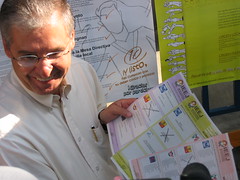
Story by DAVID AGREN
Luis Ibarra wore blue jeans and an orange T-shirt to identify his observer status for the Convergencia Socialista party (Convergence) at a polling station in Guadalajara’s Providencia neighborhood on July 2. As expected, he opted for the Convergence’s mayoral and gubernatorial candidates. But despite representing a left-wing outfit, he voted for presidential candidate Felipe Calderon of the conservative National Action Party (PAN) instead of Andres Manuel Lopez Obrador, the Convergence’s ally in a coalition dubbed, “For the good of all.”
“I’m voting for Felipe Calderon, though I’m not that fond of the right-wing,” the UNIVA law professor said, citing his disapproval of Lopez Obrador’s proposed social-welfare schemes as the main reason for going against the left-wing candidate.
In past decades, Mexicans elected the PRI for everything, but with the country’s burgeoning democratic tendencies and wide-open races for public office, voters are increasingly spliting their ballots.
“People no longer vote for a party, they vote for a candidate,” said Rene Hermosillo, who worked as a PRI observer at a polling station in Guadalajara’s Ladron de Guevara neighborhood.
Many traditional PRI voters rebelled against the national campaign, including Hermosillo, a Harley Davidson-riding gym teacher, who went for another party’s presidential candidate.
“I normally vote for the PRI, but I’m voting for the (Democratic Revolution Party) PRD on the presidential level,” he said.
Luz Elena Ramirez, a coffee shop employee, concurred. She backed Calderon for president, but also voted for Jalisco PRI gubernatorial candidate Arturo Zamora Jimenez.
“Everyone now votes for the candidate instead of the party,” Ramirez explained.
The PRI ran a miserable presidential campaign, but Zamora outpaced his federal counterparts, finishing a close second, drawing voters that backed different parties on the presidential and municipal level.
“A lot of people identify with Arturo Zamora, who don’t identify with the PRI,” said Alberto Mora, the PRI president in Guadalajara. (Several PAN supporters interviewed opted for minor-party candidates to protest their party’s lackluster performance on the state level, but wouldn't support Zamora.)
The PRD, in contrast, gained nearly 20 percent of the presidential vote in Jalisco — an all-time high — but its gubernatorial and mayoral candidates received around half as much support.
“A lot of people will vote for (Lopez Obrador), but for another party locally,” said Francisco Moya, a photographer in Guadalajara, who planned on marking ballots for both Lopez Obrador and Zamora.
According to Dan Lund, president of Mexico City market research firm Mund Americas, the ballot-splitting trend only started with the advent of competitive elections in the late 1990s.
“There have been split votes or divided ballots ever since competitive elections started about 10 years ago,” he said in a phone interview.
“In a number of states where the PAN and the PRI have been strong ... alternancy in power, that is, throw the bum out, give the other guy a chance, was almost immediately established”
Regardless of whom they selected, most voters tempered their enthusiasm when explaining their choices, often saying, “It was the least worst option.”
From the Guadalajara Reporter


No comments:
Post a Comment